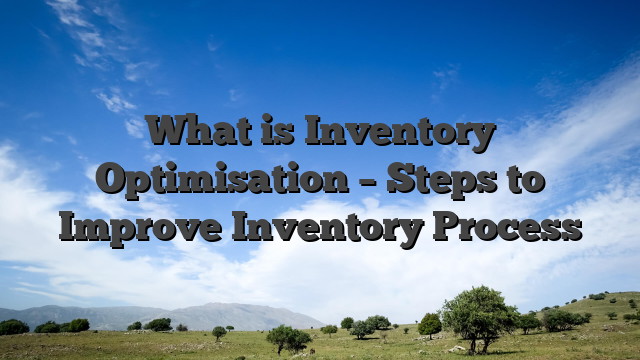In the dynamic realm of business, ensuring a seamless flow of goods is a challenge every organization faces. Central to this challenge is the need for effective inventory management, and that’s where the concept of Inventory Optimization comes into play. In this blog, we will unravel the significance of Inventory Optimization and explore the steps to enhance your inventory processes for a more streamlined and efficient operation.
Why Inventory Optimization Matters
Inventory Optimization is not just a buzzword; it’s a strategic approach that brings tangible benefits to your business. The primary driver is cost savings. By fine-tuning your inventory, you can minimize holding costs and reduce the financial strain of overstocking or stockouts. This translates into a healthier bottom line.
Beyond financial gains, Inventory Optimization contributes to improved customer satisfaction. Picture this: products readily available when customers want them, leading to increased loyalty. With the right products at the right time, your business becomes a reliable partner for your clients.
Mitigating the risk of stockouts and overstocking is another critical aspect. Stockouts can lead to missed sales opportunities and dissatisfied customers, while overstocking ties up capital and warehouse space. Inventory Optimization strikes the delicate balance between supply and demand, ensuring you stay ahead of customer needs without drowning in excess inventory.
Common Challenges in Inventory Management
Before delving into the steps to enhance your inventory processes, let’s identify some common stumbling blocks in inventory management. Overstocking is a prevalent issue. Imagine warehouses filled with products gathering dust, tying up funds that could be better utilized elsewhere. On the flip side, stockouts and backorders can be equally detrimental, tarnishing your reputation and causing customer frustration.
A crucial challenge lies in inaccurate demand forecasting. Relying on guesswork or outdated methods often leads to mismatched inventory levels. Imagine ordering excess winter coats only to find that unseasonably warm weather prevails. This discrepancy between projected and actual demand can wreak havoc on your inventory management strategy.
In the next segment of our blog, we will unravel the concrete steps you can take to overcome these challenges and elevate your inventory processes to new heights.
Steps to Improve Inventory Process
Now that we’ve outlined the importance of Inventory Optimization, let’s dive into the actionable steps you can take to enhance your inventory processes.
A. Conducting a Comprehensive Audit
Begin your journey towards a more optimized inventory process by conducting a thorough audit of your existing stock. Assess current inventory levels to identify any discrepancies between your records and the actual stock on hand. This step sets the foundation for effective inventory management.
- Assessing Current Inventory Levels
Start by physically counting your inventory. Use this opportunity to verify quantities, identify damaged or obsolete items, and ensure that your records align with the actual stock in your warehouse. This hands-on approach provides a clear snapshot of your current inventory status.
- Identifying Slow-moving and Obsolete Items
Not all items in your inventory are equal. Some move faster than others, and some may be nearing the end of their shelf life. Identify slow-moving items that tie up valuable shelf space and consider discounting or liquidating obsolete stock to free up resources.
B. Implementing Advanced Forecasting Techniques
Accurate forecasting is the backbone of successful inventory management. Leverage historical data and incorporate seasonal trends to develop a more precise understanding of demand.
- Using Historical Data
Examine past sales data to identify patterns and trends. This historical perspective equips you with valuable insights into seasonal fluctuations and helps you make informed decisions about inventory levels.
- Incorporating Seasonal Trends
Recognize that demand can vary based on seasons or specific events. Adjust your inventory levels accordingly to meet heightened demand during peak periods and avoid excess stock during slower seasons.
C. Utilizing Technology for Real-Time Tracking
Embrace technology to streamline your inventory tracking process. Barcoding and RFID systems, coupled with dedicated Inventory Management Software, provide real-time visibility into your stock levels.
- Barcoding and RFID Systems
Implementing barcoding or RFID systems simplifies the tracking of individual items, reducing errors and enhancing efficiency in your inventory processes. These technologies offer a quick and accurate way to monitor stock movements.
- Inventory Management Software
Invest in user-friendly Inventory Management Software company tailored to your business needs. These systems centralize information, automate routine tasks, and provide analytics to inform better decision-making.
D. Establishing Effective Vendor Relationships
Your suppliers play a crucial role in your inventory management. Strengthening your relationships with vendors can lead to more favorable terms and improved supply chain efficiency.
- Negotiating Optimal Order Quantities
Work closely with your suppliers to determine optimal order quantities. Negotiate bulk discounts where possible and establish a balance that prevents overstocking while ensuring a steady supply of goods.
- Streamlining Communication Channels
Effective communication is key. Maintain open lines of communication with your vendors to stay informed about lead times, potential shortages, or any changes in the supply chain that may impact your inventory.
E. Regularly Reviewing and Updating Inventory Policies
The business landscape is ever-evolving, and your inventory policies should reflect this dynamism. Regularly review and update your inventory policies to adapt to changing market conditions.
- Setting Reorder Points
Establish reorder points for your products based on historical data and sales patterns. This ensures that you replenish stock just in time, avoiding both stockouts and overstocking scenarios.
- Safety Stock Considerations
Factor in safety stock to buffer against unexpected demand spikes or delays in the supply chain. This additional layer of inventory provides a safety net, preventing disruptions to your operations.
Case Studies
Let’s delve into real-world examples that illustrate the impact of effective Inventory Optimization on businesses.
A. Success Stories of Companies Implementing Inventory Optimization
Explore how companies in various industries have successfully implemented Inventory Optimization strategies to enhance efficiency, reduce costs, and elevate their overall business performance.
B. Lessons Learned from Real-World Examples
Extract valuable lessons from these success stories. Understand the challenges these companies faced and how they overcame them, providing insights that can be applied to your own inventory management strategy.
Future Trends in Inventory Optimization
The landscape of inventory management is continually evolving. Stay ahead of the curve by exploring upcoming trends that are set to shape the future of Inventory Optimization.
A. Automation and Artificial Intelligence
Discover how automation and artificial intelligence are revolutionizing inventory processes. From predictive analytics to robotic automation, these advancements offer opportunities for increased efficiency and accuracy.
B. Integration with Supply Chain Management Systems
Explore the benefits of integrating Inventory Optimization with broader supply chain management systems. This seamless integration enhances visibility across the entire supply chain, allowing for more informed decision-making.
Read More – Inventory Management System for Small Business
Conclusion
In this comprehensive exploration of Inventory Optimization, we’ve covered the fundamental steps to enhance your inventory processes. From conducting audits to leveraging technology and establishing effective vendor relationships, these strategies empower you to navigate the complexities of inventory management successfully.
Stay tuned for future trends that promise to shape the landscape of Inventory Optimization. As you embark on this journey, remember that optimizing your inventory is not just a process; it’s a strategic investment in the long-term success of your business.




